Plants that smell good — they’re the subject of poems and songs, we arrange their flowers into bouquets for loved ones, and we turn their aromatic oils into perfumes, essential oils, and bathing products. Unless you’re scent-sensitive, you’ve probably enjoyed leaning your nose to the blooms of a wonderfully fragrant flower and inhaling the pungent aroma. And it’s not just humans who love nice-smelling plants. Plants release fragrances that mimic enticing pheromones from their flowers to attract a variety of pollinators, such as bees.
To celebrate the aromas of the plant world, we’ve compiled a list of six fragrant plants that attract pollinators and our noses alike!
6 Plants That Smell Good
Check out these six plants that smell good and, in some cases, taste wonderful too! We’ll cover their scents, how we use them, and provide growing tips too.
1. Southern Magnolia (Magnolia grandiflora)
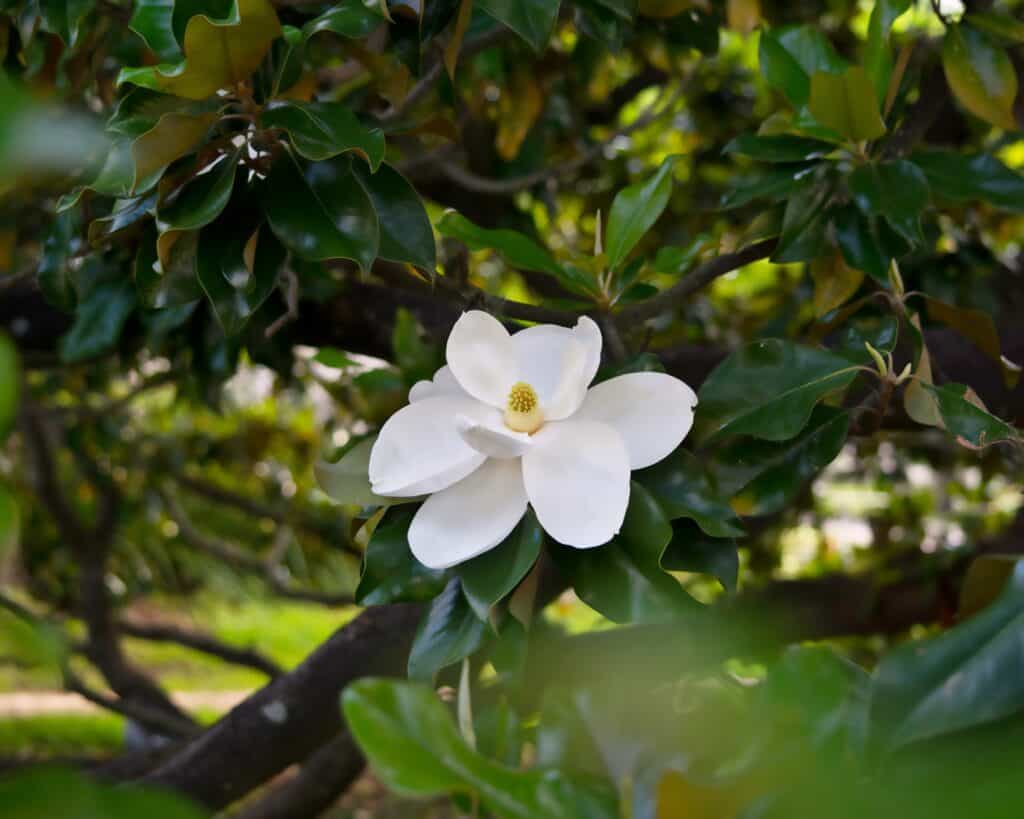
Southern magnolia flowers are well-known for their sweet, lemony fragrance, which is often used in aromatherapy to induce a calm feeling and atmosphere.
©iStock.com/Dwbenjam
Native to the Southeastern United States, Southern magnolias (Magnolia grandiflora) are famed for their large, elegant, and wonderful-smelling flowers. While the genus Magnolia includes about 120 species of shrubs and trees, the Southern magnolia is a favorite for its stunning blooms that produce a softly sweet and lemony smell.
In aromatherapy, Southern magnolia essential oil is popular for its calming, refreshing scent.
A bonus of growing this lovely-smelling tree is its glossy, broad evergreen leaves that make it a fantastic landscaping option.
In its native growing range, the Southern magnolia is hardy, adaptable to a variety of soils, and resistant to disease. Additionally, this fragrant tree can thrive in USDA growing Zones 6-10. At maturity, expect the Southern magnolia to grow to a height of 60-80 feet with a 40-foot spread. Its flowering season is typically May through June, but that can extend by a few weeks in the Southern end of its growing range.
2. Common Honeysuckle (Lonicera periclymenum)
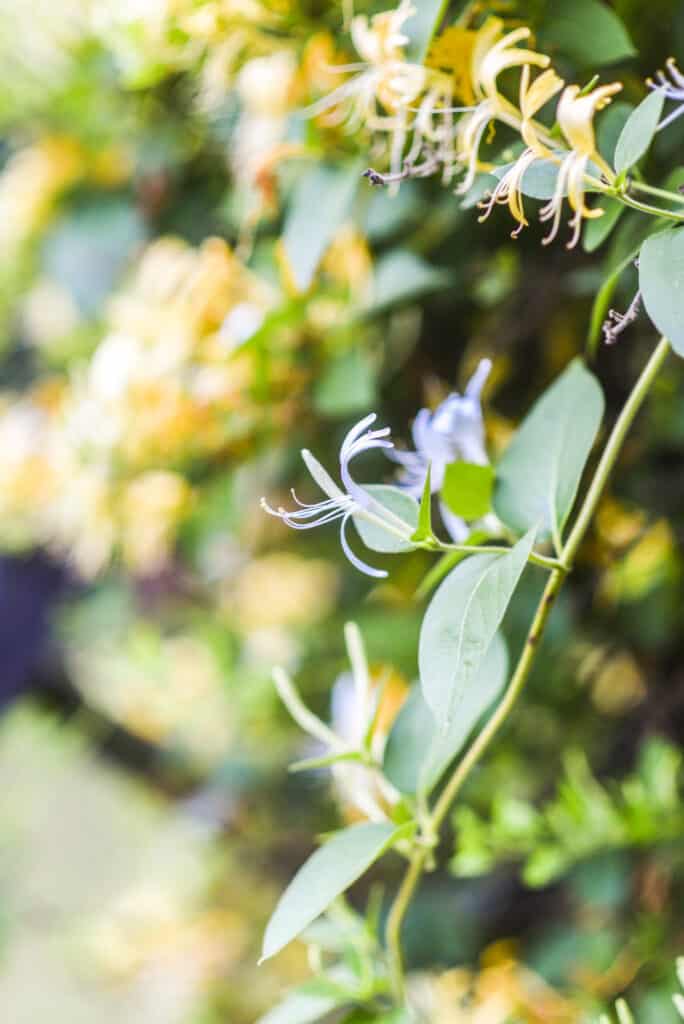
Not only do common honeysuckles smell good, but they also produce a sweet, honey-like nectar that is edible!
©iStock.com/Kamila Kozioł
Of the 180 species belonging to the honeysuckle genus, Lonicera, the common honeysuckle (Lonicera periclymenum), is one of the most widely recognized and enjoyed. Also known as woodbine, it’s native across North Africa, West Asia, and Europe, and is naturalized to parts of North America. This lovely twisting vine produces clusters of small, strongly sweet, and floral-smelling upright tubular flowers. Typically, these flowers are displayed in gradients of yellow, white, and pink.
In addition to making our top list of plants that smell good, the flowers also contain sweet, honey-like nectar that we humans, along with other critters, have enjoyed for thousands of years. In fact, as you might have guessed, the common name “honeysuckle” refers to sucking the sweet nectar from the hollow petals.
To enjoy honeysuckle’s sweet nectar:
- Pluck the entire flower from the vine, including the tiny green bud at the bottom tip of the flower.
- Pinch firmly just above the bud.
- Slowly and gently pull the bud and the attached string-like style away from the flower.
- Stop pulling once you see a small drop of nectar that should pool at the bottom of the flower.
- Suck the drop and enjoy this sweet little treat!
Common honeysuckle can thrive in USDA growing Zones 4-10. This adaptable plant can thrive in a variety of soils, including alkaline or acidic, and is drought-tolerant once established. As a woodland and edge-of-the-forest plant, it prefers dappled sunlight. This species of honeysuckle usually blooms from June through September.
3. Sweet Pea (Lathyrus odoratus)
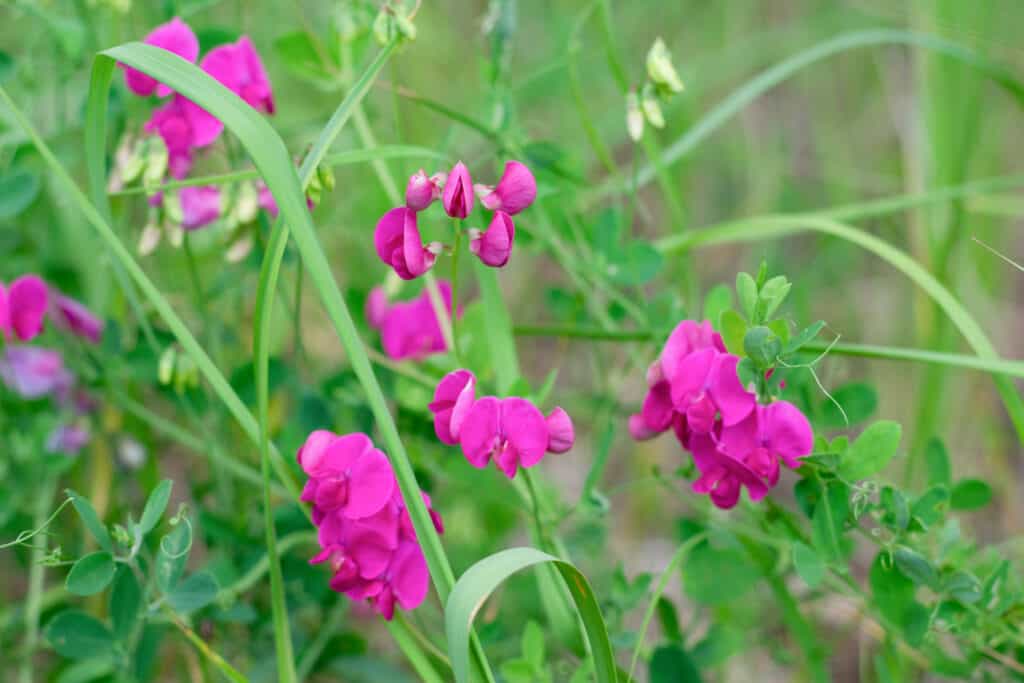
Sweet peas have been cultivated since the 17th century and have a pleasant honey-orange blossom scent.
©iStock.com/Leisan Rakhimova
Belonging to the diverse pea family (Fabaceae), the sweet pea (Lathyrus odoratus) is an annual, ornamental flowering bushy or climbing plant that produces highly fragrant, colorful, and delicate wing-shaped flowers. Native to Southern Italy, Sicily, and the Aegean islands, this Mediterranean plant is well-loved for its potently sweet floral fragrance.
Cultivated since the 17th century, this species is available in many cultivars that produce varying flower colors, blooming lengths, scents, and growing habits. With its pleasant honey-orange blossom scent, sweet pea flowers are often used in perfumes and bath products. Interestingly, a tip from The 1899 Old Farmer’s Almanac encouraged caretakers to place sweet pea flowers in the rooms of sick loved ones, which supposedly drove away flies, who were repulsed by the scent, while bringing a pleasant, comforting smell to the patients.
Despite their notably fragile appearance, sweet peas are cold-hardy plants that can thrive in USDA growing Zones 2-11. Planting times and blooming seasons vary throughout this wide range of growing Zones. Pre-19th century cultivars, such as Painted Lady, Queen of the Night, and Original Cupani, are known for their particularly strong scent with robust stems, and a long blooming season of June to September.
4. Common Jasmine (Jasminum officinale)
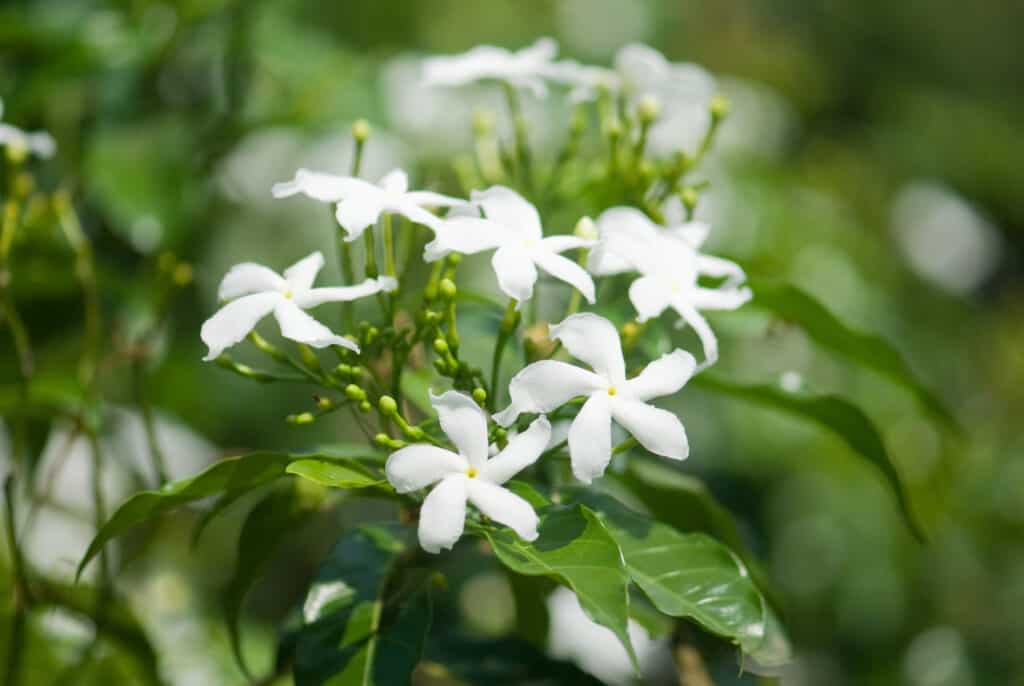
Jasmine plants typically have small, star-shaped flowers.
©Tukaram.Karve/Shutterstock.com
Native to the Middle East through Central China, common jasmine (Jasminum officinale) is famed and beloved for its pungently sweet, slightly musky, and honey-like scent. People have used the flower’s pungent aromatic oils in fragrances, aromatherapy, and bathing products for thousands of years. It’s no wonder jasmine has a spot on our list of plants that smell good.
Belonging to the olive family (Oleaceae), the genus Jasminum comprises over 200 species of warm-loving shrubs and vines with fragrant white, yellow, or white-pink blossoms.
Common jasmine, also known as poet’s jasmine and true jasmine, produces star-shaped white blossoms on an evergreen vine. This vigorous, climbing vine can grow up to 40 feet with a 15-foot spread.
Adaptable to many growing conditions, common jasmine can thrive in a variety of soils and is drought and air-pollution-tolerant. Its ideal growing condition, however, is in well-drained, moist, light soil. Jasmine is hardy in USDA growing Zones 7-10, but you can also grow it in a container in colder regions and bring it inside during the fall and winter.
5. Common Lilac (Syringa vulgaris)
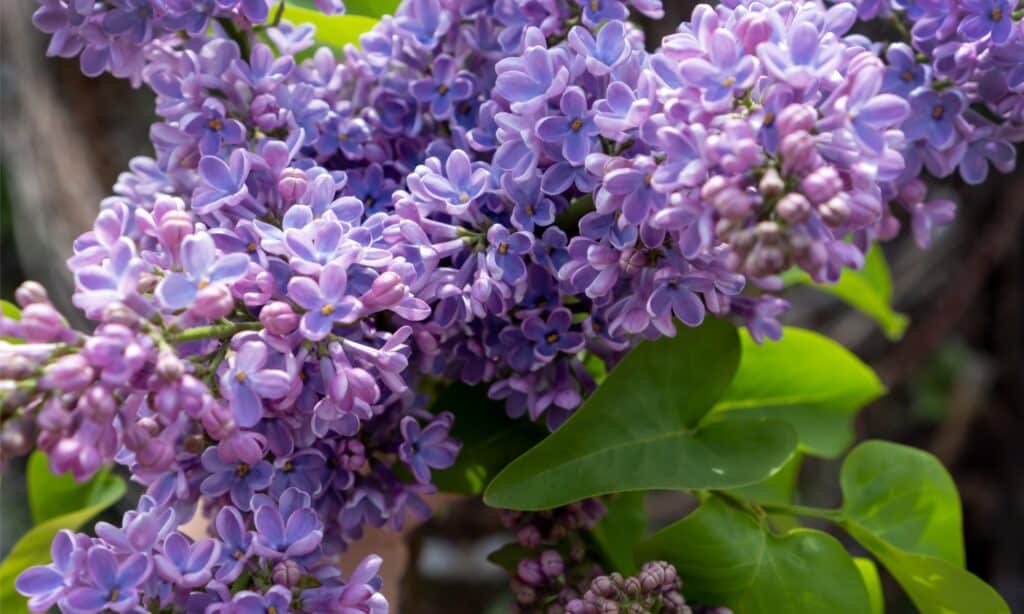
Lilacs produce blooms for a short time in the spring and are best planted in the fall.
©iStock.com/Diana Ibrasheva
A highly fragrant shrub favored for use in landscaping, common lilac (Syringa vulgaris) produces clusters of gorgeous, pungently sweet purple flowers upon upright stalks. Native to the cooler regions of Europe, common lilac is now naturalized across much of Northeastern North America.
For landscaping, common lilac looks lovely grown in a line as shrubs along a boundary or as individual plants pruned as small trees. Depending on how it’s maintained, this sweet-smelling shrub can grow between 6-16 feet tall with a spread of 6-12 feet.
Not only do these lilac blooms smell wonderful, but common lilac flowers are also edible! You can either eat the flowers raw or batter and fry them for delicious lilac fritters.
The fragrance of lilac is delicate and reminiscent of spring. As early bloomers, lilac flowers are a sign of spring and renewed life. In cooler regions, where these plants thrive, lilac blooming can last from April through mid-June. In warmer areas, expect only a month or so of blooming from this cold-hardy beauty.
Once lilac shrubs are done blooming, they are rather unremarkable. So, some gardeners grow them alongside other plants that have more interesting foliage, extended blooming times, or attractive growth habits to balance the subdued look of non-blooming common lilacs.
6. Balsam Fir (Abies balsamea)
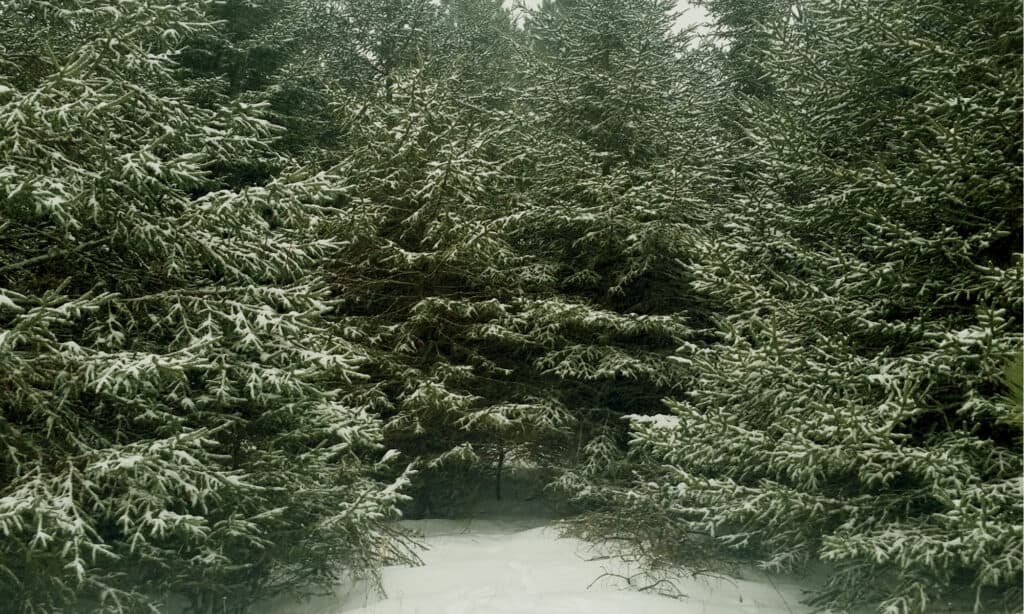
Even without colorful blossoms,
balsam fir
trees have a wonderful fragrance that many people especially enjoy at Christmastime.
©Sonia Horowitz/Shutterstock.com
One of our favorite plants that smell good isn’t your typical garden flower, but a member of the pine family (Pinaceae), balsam fir (Abies balsamea). This fir tree is a wonderfully aromatic evergreen conifer native to Eastern North America.
A popular Christmas tree choice, this lovely fir’s needles produce a comforting woodsy, softly balsamic vinegar-like scent. Many people choose it for a Christmas tree precisely for its lovely aroma that gently fills an indoor space.
The needles of balsam fir also make a wonderfully aromatic tea with studied health benefits such as potent antioxidants and a high amount of vitamins A and C. After brewing this fragrant tea, you’ll enjoy the soothing aroma as much as sipping it down!
As a cold-hardy conifer native to the Northeast, balsam firs thrive in USDA hardiness Zones 3-5. Expect a height of 45-75 feet and a spread of 20-25 feet at maturity. These plants prefer slightly acidic, well-draining soil and about four hours of full sun followed by partial shade.
Up Next:
- Different Types of Magnolia Trees
- Roses in Texas That are Perfect for Gardens
- Are Essential Oils Safe for Cats?
The photo featured at the top of this post is © iStock.com/Natasha_Chaika
Sources
- University of Georgia Extension, Available here: https://extension.uga.edu/publications/detail.html?number=C974
- North Carolina Extension Garner Plant Toolbox, Available here: https://plants.ces.ncsu.edu/plants/lonicera-periclymenum/
- Missouri Botanical Garden, Available here: https://www.missouribotanicalgarden.org/PlantFinder/PlantFinderDetails.aspx?kempercode=b734
- Almanac, Available here: https://www.almanac.com/plant/sweet-peas
- National Library of Medicine, Available here: https://pubmed.ncbi.nlm.nih.gov/20184043/
- Missouri Botanical Garden, Available here: http://www.missouribotanicalgarden.org/PlantFinder/PlantFinderDetails.aspx?kempercode=b559
- North Carolina Extension Garner Plant Toolbox, Available here: https://plants.ces.ncsu.edu/plants/syringa-vulgaris/
- National Library of Medicine, Available here: https://www.ncbi.nlm.nih.gov/pmc/articles/PMC7827367/
- Ohio Department of Natural Resources, Available here: https://ohiodnr.gov/discover-and-learn/education-training/wild-ohio-harvest-cookbook/foraging-recipes/pine-needle-tea
Thank you for reading! Have some feedback for us? Contact the AZ Animals editorial team.






